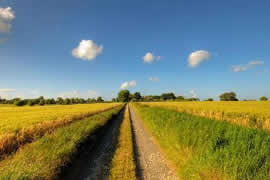使用CSS3进行增强
滑过文字渐变
/* 这段代码实现了当鼠标滑过链接时的渐变效果 */
a {
color: #007c21;
transition: color .4s ease;
}
a:hover { color: #00bf32; }
为元素创建圆角
使用CSS3可以在不引入额外的标记或图像的情况下,为大多数元素(包括表单元素、图像,甚至段落文本)创建圆角。
<!DOCTYPE html>
<html lang="en">
<head>
<meta charset="utf-8" />
<title>Rounded Corners</title>
<link rel="stylesheet" href="css/rounded-corners.css" />
</head>
<body>
<p class="all-corners"></p>
<p class="one-corner"></p>
<p class="elliptical-corners"></p>
<p class="circle"></p>
</body>
</html>
使用CSS圆角的四个例子,包含了必要的厂商前缀以支持旧版的Android、Mobile Safari和Safari浏览器。对于.circle,使用75px与50%的效果是一样的,因为该元素的大小为150像素*150像素。
p {
background: #999;
float: left;
height: 150px;
margin: 10px;
width: 150px;
}
.all-corners {
-webkit-border-radius: 20px;
border-radius: 20px;
}
.one-corner {
-webkit-border-top-left-radius: 75px;
border-top-left-radius: 75px;
}
.elliptical-corners {
-webkit-border-radius: 50px / 20px;
border-radius: 50px / 20px;
}
.circle {
-webkit-border-radius: 50%;
border-radius: 50%;
}
p {
background: #ff9;
border: 5px solid #326795;
float: left;
height: 150px;
margin: 10px;
width: 150px;
}
.example-1 {
/* Makes the radius of the top-left and bottom-right corners 10px and
the top-right and bottom-left corners 20px */
border-radius: 10px 20px;
}
.example-2 {
/* Makes the radius of the top-left corner 20px, and all other corners 0 */
border-radius: 20px 0 0;
}
.example-3 {
/* Makes the radius of the top-left corner 10px, the top-right corner 20px,
the bottom-right corner 0, and the bottom-left corner 30px */
border-radius: 10px 20px 0 30px;
}
为元素创建四个相同的圆角
-
这一步是可选的,输入
-webkit-border-radius: r,这里的r是圆角的半径大小,表示为长度(带单位)。 -
输入
border-radius: r,这里的r是圆角的半径大小,使用与第一步中相同的值。这是该属性的标准短形式语法。
为元素创建一个圆角
-
这一步是可选的,输入
-webkit-border-top-left-radius: r,这里的r是左上方圆角的半径大小,表示为长度(带单位)。 -
输入
border-top-left-radius: r,这里的r使用与第一步中相同的值。这是该属性的标准长形式语法。 -
创建右上方圆角使用
top-right;创建右下方圆角使用bottom-right;创建左下方圆角使用bottom-left。
创建椭圆形圆角
-
这一步是可选的,输入
-webkit-border-radius: x/y,其中x是圆角在水平方向上的半径大小,y是圆角在垂直方向上的半径大小,均表示为长度(带单位)。 -
输入
border-radius: x/y,其中x和y跟第一步中的值相等。
使用border-radius(属性不是继承的)创建图形
-
输入
-webkit-border-radius: r这里的r是元素的半径大小(带长度单位)。要创建圆形,可以使用短形式的语法,r的值应该等于元素高度或宽度的一半。 -
输入
border-radius: r这里的r是元素的半径大小(带长度单位),跟第一步中的r相等。这是标准的无前缀语法。
注:不支持border-radius的旧的浏览器仅会以方角呈现元素。border-radius仅影响施加该样式的元素的角,不会影响其子元素的角。因此如果一个子元素有背景,该背景就有可能显示在一个或多个父元素的角的位置,从而影响圆角样式。有时元素的背景(这里讲的不是子元素的背景)会透过其圆角。为了避免这种情况,可以在元素的border-radius声明后面增加一条样式规则:background-clip: padding-box;。
为文本添加阴影
使用text-shadow可以在不使用图像表示文本的情况下,为段落、标题等元素中的文本添加动态的阴影效果。
为元素的文本添加阴影
-
输入
text-shadow:。 -
分别输入表示
x-offset(水平偏移量)、y-offset(垂直偏移量)、blur-radius(模糊半径)和color的值(前三个值带长度单位,四个值之间不用逗号分隔),例如-2px 3px 7px #999。
为元素的文本添加多重阴影
-
输入
text-shadow:。 -
分别输入
x-offset(水平偏移量)、y-offset(垂直偏移量)、blur-radius(模糊半径)和color的值(前三个值带长度单位,四个值之间不用逗号分隔)。blur-radius的值是可选的。 -
输入,(逗号)。
-
对四种属性使用不同的值重复第二步。
<!DOCTYPE html>
<html lang="en">
<head>
<meta charset="utf-8" />
<title>Text Shadow</title>
<link rel="stylesheet" href="css/text-shadow.css" />
</head>
<body>
<p class="basic">Basic Shadow</p>
<p class="basic-negative">Basic Shadow</p>
<p class="blur">Blur Radius</p>
<p class="blur-inversed">Blur Radius</p>
<p class="multiple">Multiple Text Shadows</p>
</body>
</html>
body {
background: #fff;
color: #222;
font: 100%/1.05 helvetica, sans-serif;
padding-top: 20px;
}
p {
color: #222; /* nearly black */
font-size: 4.5em;
font-weight: bold;
margin: 0 0 45px;
}
p:last-child {
margin: 0;
}
.basic {
text-shadow: 3px 3px #aaa;
}
/* uses negative offsets--you can mix positive and negative ones, too. */
.basic-negative {
text-shadow: -4px -2px #ccc; /* a little lighter grey than #aaa */
}
.blur {
text-shadow: 2px 2px 10px grey;
}
.blur-inversed {
color: white;
text-shadow: 2px 2px 10px #000; /* black */
}
/* this example has two shadows, but you can include
more by separating each with a comma */
.multiple {
text-shadow:
2px 2px white,
6px 6px rgba(50,50,50,.25);
}
这些类演示了几种text-shadow的效果。第一个、第二个和第五个都省略了模糊半径的值。.multiple类告诉我们,可以为单个元素添加多个阴影样式,每组属性之间用逗号分隔。这样,通过结合使用多个阴影样式,可以创建出特殊而有趣的效果。
将text-shadow(属性是继承的)改回默认值
即输入text-shadow: none;,这个属性不需要输入使用厂商前缀。
text-shadow属性接受四个值:带长度单位的x-offset、带长度单位的y-offset、可选的带长度单位的blur-radius以及color值。如不指定blur-radius,将假定其值为0。x-offset和y-offset值可以是正整数也可以是负整数,也就是说1px和-1px都是有效的。blur-radius值必须是正整数。这三个值都可以为0。尽管text-shadow的语法与边框和背景属性的语法是类似的,但它不能像边框和背景那样单独的指定四个属性值。如果不指定text-shadow,它就会使用初始值none。
为其他元素添加阴影
使用text-shadow属性可以为元素的文本添加阴影,使用box-shadow属性则可以为元素本身添加阴影。他们的基础属性集是相同的,不过box-shadow还允许使用使用两个可选的属性:inset关键字属性和spread属性(用于扩张或收缩阴影)。
box-shadow属性接受六个值:带长度单位的x-offset和y-offset、可选的带长度单位的blur-radius、可选的inset关键字、可选的带长度单位的spread值及color值。如果不指定blur-radius和spread的值,则设为0。
<!DOCTYPE html>
<html lang="en">
<head>
<meta charset="utf-8" />
<title>Box Shadow</title>
<link rel="stylesheet" href="css/box-shadow.css" />
</head>
<body>
<p class="shadow">
<p>Shadow with Blur</p>
</p>
<p class="shadow-negative">
<p>Shadow with Negative Offsets and Blur</p>
</p>
<p class="shadow-spread">
<p>Shadow with Blur and Spread</p>
</p>
<p class="shadow-offsets-0">
<p>Shadow with Offsets Zero, Blur, and Spread</p>
</p>
<p class="inset-shadow">
<p>Inset Shadow</p>
</p>
<p class="multiple">
<p>Multiple Shadows</p>
</p>
<p class="shadow-negative-spread">
<p>Shadow with Blur and Negative Spread</p>
</p>
</body>
</html>
body {
background: #000;
color: #fff;
}
h1 {
font-family: sans-serif;
font-size: 2.25em;
line-height: 1.1;
text-align: center;
}
/* NOTE: The background-image URLs are different below than in the example shown in the book, because I've placed the images in a sub-folder (called "img"), as is typical when organizing a site. Also, I thought it would be helpful for you to see how to construct your background-image URLs under these circumstances. Note that the URLs are relative to where the style sheet lives, NOT the HTML page that is displaying the image. */
.night-sky {
background-color: navy; /* fallback color */
background-image:
url(../img/ufo.png),
url(../img/stars.png),
url(../img/stars.png),
url(../img/sky.png);
background-position:
50% 102%,
100% -150px,
0 -150px,
50% 100%;
background-repeat:
no-repeat,
no-repeat,
no-repeat,
repeat-x;
height: 300px;
margin: 25px auto 0; /* slightly different than book */
padding-top: 36px;
width: 75%;
}
上面程序用于演示使用box-shadow添加一个或多个阴影的效果。前五个类各自应用了一个彼此不同的阴影样式。最后一个类应用了两个阴影(还可以应用更多个阴影)。不理解box-shadow的浏览器会直接忽略这些CSS样式规则,呈现没有阴影的页面。
为元素添加阴影
-
输入
-webkit-box-shadow:。 -
分别输入表示
x-offset、y-offset、blur-radius、spread和color的值(前四个值均带长度单位),例如2px2px5px#333。 -
输入
box-shadow:,再重复第二步。
创建内阴影
-
输入
-webkit-box-shadow:。 -
分别输入表示表示
x-offset、y-offset、blur-radius、spread和color的值(前四个值均带长度单位),例如2px2px5px#333。 -
在冒号后输入
inset,再输入一个空格(也可以在第二步之前输入inset和一个空格)。 -
输入
box-shadow:,再重复第二步和第三步。
为元素应用多重阴影
-
输入
-webkit-box-shadow:。 -
分别输入表示表示
x-offset、y-offset、blur-radius、spread和color的值(前四个值均带长度单位),例如2px2px5px#333。如果有必要,将inset关键字包含在内。 -
输入逗号。
-
对每种属性使用不同的值重复第二步。
-
输入
box-shadow:,再重复第二步至第四步。
将box-shadow(属性是不继承的)改回默认值
-
输入
-webkit-box-shadow: none;。 -
输入
box-shadow: none;。
注:x-offset、y-offset和spread值可以是正整数,也可以是负整数。blur-radius值必须是正整数。这三个值都可以为零。inset关键字可以让阴影位于元素内部。
应用多重背景
多重背景几乎可以应用于任何元素。
<!DOCTYPE html>
<html lang="en">
<head>
<meta charset="utf-8" />
<title>Multiple Backgrounds</title>
<link rel="stylesheet" href="css/multiple-backgrounds.css" />
</head>
<body>
<p class="night-sky">
<h1>In the night sky...</h1>
</p>
</body>
</html>
...
.night-sky {
background-color: navy; /* fallback color */
background-image:
url(../img/ufo.png),
url(../img/stars.png),
url(../img/stars.png),
url(../img/sky.png);
background-position:
50% 102%,
100% -150px,
0 -150px,
50% 100%;
background-repeat:
no-repeat,
no-repeat,
no-repeat,
repeat-x;
height: 300px;
margin: 25px auto 0; /* slightly different than book */
padding-top: 36px;
width: 75%;
}
为单个元素应用多重背景图像(不需要使用厂商前缀)
-
输入
background-color: b,这里的b是希望为元素应用的备用背景颜色。 -
输入
background-image: u,这里的u是绝对或相对路径引用的url列表(用逗号分隔。支持多重背景的浏览器,图像是分层次相互重叠在一起的,用逗号分隔的列表中的第一个图像位于顶部。) -
输入
background-position: p,这里的p是成对的x-offset和y-offset(可以是正的,也可以是负的;带长度单位或者关键字,如center top)的集合,用逗号分隔。对于第二步中指定的每个url,都应有一组x-offset和y-offset。 -
输入
background-repeat: r,这里的r是repeat-x、repeat-y或no-repeat值,用逗号分隔,第二步中指定的每个url对应一个值。
对于多重背景图像,可以使用标准的短形式语法,即使用逗号分隔每组背景参数。这种表示方法的好处是开发者既可以指定备用背景颜色,也可以为旧的浏览器指定图像。
.night-sky {
/* fallback with both a color and image */
background: navy url(../img/ufo.png) no-repeat center bottom;
/* for supporting browsers */
background:
url(../img/ufo.png) no-repeat 50% 102%,
url(../img/stars.png) no-repeat 100% -150px,
url(../img/stars.png) no-repeat 0 -150px,
url(../img/sky.png) repeat-x 50% 100%;
height: 300px;
margin: 25px auto 0;
padding-top: 36px;
width: 75%;
}
使用渐变背景
<!DOCTYPE html>
<html lang="en">
<head>
<meta charset="utf-8" />
<title>Gradient Backgrounds</title>
<link rel="stylesheet" href="css/gradients.css" />
</head>
<body>
<p class="vertical-down"><p>default</p></p>
<p class="vertical-up"><p>to top</p></p>
<p class="horizontal-rt"><p>to right</p></p>
<p class="horizontal-lt"><p>to left</p></p>
<p class="angle-bot-rt"><p>to <br />bottom right</p></p>
<p class="angle-bot-lt"><p>to <br />bottom left</p></p>
<p class="angle-top-rt"><p>to top right</p></p>
<p class="angle-top-lt"><p>to top left</p></p>
<p class="angle-120deg"><p>120deg</p></p>
<p class="angle-290deg"><p>290deg</p></p>
<section class="radial">
<p class="radial-center"><p>default</p></p>
<p class="radial-top"><p>at top</p></p>
<p class="radial-size-1"><p>100px, 50px</p></p>
<p class="radial-size-2"><p>70% 90% at <br />bottom left</p></p>
<p class="radial-various-1"><p>various 1</p></p>
<p class="radial-various-2"><p>various 2</p></p>
</section>
<section class="color-stops">
<p class="color-stops-1"><p>yellow 10%, green</p></p>
<p class="color-stops-2"><p>to top right, yellow, <br />green 70%, <br />blue</p></p>
</section>
</body>
</html>
body {
padding: 1.25em; /* 20px/16px, so 20px on each side */
font-size: 100%;
}
p {
float: left;
height: 150px;
margin: 10px;
width: 150px;
}
p {
color: #fff;
font: bold 1.25em/1 sans-serif; /* 20px/16px */
padding-top: 1.65em; /* 33px/16px */
text-align: center;
}
/* NOTE: The gradients below are in the standard CSS3 syntax. The browsers that support them are Chrome 26+, Firefox 16+, IE 10+, and Opera 12.10+. See gradients-with-browser-prefixes.css for the same gradient effects, but with the vendor prefix code also included so the gradients will work on several older browsers.A background with a "fallback" comment is the color that will show in browsers that don't support the gradient syntax. You can use a backgroundimage as a fallback as well (either on its own or in combination with a color).For example, background: red url(gradient-image.jpg) no-repeat;. */
/* LINEAR GRADIENTS
------------------------------------------ */
/* :::: Vertical :::: */
.vertical-down {
background: silver; /* fallback */
/* default gradient, so you don't need to specify "to bottom" before the colors */
background: linear-gradient(silver, black);
}
.vertical-up {
background: silver;
background: linear-gradient(to top, silver, black);
}
/* :::: Horizontal :::: */
.horizontal-rt {
background: silver; /* fallback */
background: linear-gradient(to right, silver, black);
}
.horizontal-lt {
background: silver; /* fallback */
background: linear-gradient(to left, silver, black);
}
/* :::: Diagonal Angles :::: */
/* Note: The figures on page 377 show aqua as the fallback color, but I've switched it
to navy below because the white text will be easier to read on a navy background. */
.angle-bot-rt {
background: navy; /* fallback */
background: linear-gradient(to bottom right, aqua, navy);
}
.angle-bot-lt {
background: navy; /* fallback */
background: linear-gradient(to bottom left, aqua, navy);
}
.angle-top-rt {
background: navy; /* fallback */
background: linear-gradient(to top right, aqua, navy);
}
.angle-top-lt {
background: navy; /* fallback */
background: linear-gradient(to top left, aqua, navy);
}
/* :::: Angles via Degrees :::: */
.angle-120deg {
background: navy; /* fallback */
background: linear-gradient(120deg, aqua, navy);
}
.angle-290deg {
background: navy; /* fallback */
background: linear-gradient(290deg, aqua, navy);
}
/* RADIAL GRADIENTS
------------------------------------------ */
/* :::: Radial :::: */
.radial p {
text-shadow: 0 0 3px #000;
}
.radial-center {
background: red; /* fallback */
background: radial-gradient(yellow, red); /* default */
}
.radial-top {
background: red; /* fallback */
background: radial-gradient(at top, yellow, red);
}
.radial-size-1 {
background: red; /* fallback */
background: radial-gradient(100px 50px, yellow, red);
}
.radial-size-2 {
background: red; /* fallback */
background: radial-gradient(70% 90% at bottom left, yellow, red);
}
.radial-various-1 {
background: red; /* fallback */
background: radial-gradient(closest-side at 70px 60px, yellow, lime, red);
}
.radial-various-2 {
background: red; /* fallback */
background: radial-gradient(30px 30px at 65% 70%, yellow, lime, red);
}
/* LINEAR GRADIENTS WITH COLOR STOPS
------------------------------------------ */
.color-stops p {
margin-bottom: 30px;
}
.color-stops p {
padding-top: 25px;
text-shadow: 0 0 3px #000;
}
.color-stops-2 p {
font-size: 18px;
line-height: 1.05;
}
.color-stops-1 {
background: green; /* fallback */
background: linear-gradient(yellow 10%, green);
}
.color-stops-2 {
background: green; /* fallback */
background: linear-gradient(to top right, yellow, green 70%, blue);
}
创建备用背景颜色
输入background: color或者background-color: color,这里的color可以是十六进制数、RGB值以及其他任何支持的颜色名称,另外也可以使用图像。最好不要将RGBA、HSL或HSLA值作为备用背景颜色(如果你不打算支持IE则不必在意),因为IE8及以前的版本不支持。
定义线性渐变
-
输入
background: linear-gradient(。 -
如果希望渐变方向是从上向下(默认方向),则可以跳过这一步。输入方向后面加一个逗号,方向指
to top、to right、to bottom right、to top right等这样的值。或者输入方向后面加一个逗号,这里的方向指的是角度值(如45deg、107deg等)。 -
根据后面讲到的“指定颜色”等,定义渐变颜色。
-
输入
);完成渐变。
定义径向渐变
-
输入
background: radial-gradient(。 -
指定渐变的形状。希望指定尺寸则可根据第三步中指定的尺寸自行确定。否则输入
circle或ellipse。 -
指定渐变的尺寸。如果希望尺寸为自动指定的值(默认值为·farthest-corner·,最远的角),则跳过这一步。否则输入代表渐变宽度和高度的一个长度值(如
200px或7em)或代表宽度和高度的一对值(390px175px或60%85%)。注意,如果只使用一个值,则这个值不能是百分数。或者输入closest-side、farthest-side、closest-corner或farthest-corner。这些关键字代表相对于渐变的中心,渐变可以伸展到多大的空间。边界决定了渐变的尺寸。 -
指定渐变的位置。希望渐变的位置从元素的中心开始(默认值)则可跳过这一步。输入
at top、at right、at bottom left、at top right等表示渐变中心位置的值。或者输入表示渐变中心位置的一对坐标,并以at开头,例如at 200px 43px、at 30% 40%、at 50% -10px等。 -
定义渐变颜色。
-
输入
);完成渐变。
指定颜色
输入至少两种颜色,每种颜色之间用逗号分隔。指定的第一个颜色出现在渐变的开始位置,最后一个出现的颜色出现在渐变的结束位置。对于径向渐变,它们分别为最里边的颜色和最外边的颜色。
为元素设置不透明度
opacity属性不继承。
使用opacity属性可以修改元素的透明度。方法是输入opacity: x,这里的x表示元素元素的不透明程度(两位小数,不带单位)。
opacity的默认值为1(完全不透明),范围为0~1。
通过使用opacity属性和:hover伪属性,可以产生一些有趣且实用的效果。例如img { opacity: .75; }默认情况下可以将图片设置为75%的不透明度,img:hover { opacity: 1; }可导致用户鼠标停留在元素上时元素变为不透明。在将缩略图链接到全尺寸版本时经常看到这种效果。对于访问者来说,悬浮可增强图像的动感。
opacity属性与使用RGBA或HSLA设置的透明背景色是两个容易混淆的概念。opacity影响的是整个元素(包括其内容),而background-color: rgba(128,0,64,.6);这样的设置仅影响背景的透明度。
生成内容的效果
使用:before和:after伪元素可以很方便地为页面添加一些令人难以置信的设计效果。它们可以与content属性结合使用,从而创建所谓的生成内容。生成内容指的是通过CSS创建的内容而不是HTML生成的。
... <p>This area is one of the most tranquil spaces at the Villa. As I wandered around, enjoying shade provided by sycamore and laurel trees and serenaded by splashing water from two sculptural fountains, I couldn't help but think … <a href="victoria.html" class="more">Read More</a></p> ...
/* The generated content */
.more:after {
content: " »";
}
通过上面代码,可以使带有class="more"的元素会在其后显示一个双箭头,以后如需变动,修改也只需要修改.more类即可,而不需要改动大量的HTML页面。
使用sprite拼合图像
浏览器中文本显示速度很快,但是图像往往会减慢页面的加载速度。为解决这一问题,可以将多个图像拼合成单个背景图像(sprite),再通过CSS控制具体显示图像的哪一部分,使用的就是background-position属性。
.documents li {
margin-top: .45em;
}
/* Each link in the HTML has this class */
.icon {
display: inline-block;
line-height: 1.1;
font-size: .875em;
min-height: 16px; /* set to height of icon so it isn't cut off at all */
padding-left: 23px;
padding-top: 2px;
/* allows positioning the icon absolutely relative to elements with class="icon" in the HTML */
position: relative;
}
.icon:before {
background-image: url(../img/sprite.png);
content: " ";
display: block;
height: 16px; /* icon height */
left: 0; /* default. change this if want the icon to appear in different spot */
position: absolute;
width: 16px; /* icon width */
top: 0; /* default. change this if want the icon to appear in different spot */
}
/* Shift position of sprite image for any document filename that ends with .xls */
a[href$=".xls"]:before {
background-position: -17px 0;
}
/* Shift position of sprite image for any document filename that ends with .docx */
a[href$=".docx"]:before {
background-position: -34px 0;
}
可以将sprite应用于任意数量的元素。在上面这个例子中,使用.icon:before来实现所需的效果。这样sprite就是通过content: " ";生成的空格的背景图像。将其设置为display: block;,从而就可以设置与图标大小匹配的高度和宽度。没有这三个属性,图像将不会显示。通过使用background-position,可以将正确的图标放入该位置。
以上就是使用CSS3进行样式效果增强的详细介绍的详细内容,更多请关注css教程其它相关文章!


![[自用笔记]利用@media screen实现网页布局的自适应手机端显示导航公告背景](https://www.qieseo.com/wp-content/themes/begin/prune.php?src=https://www.qieseo.com/wp-content/uploads/2018/05/DHBJ.png&w=280&h=210&a=&zc=1)






